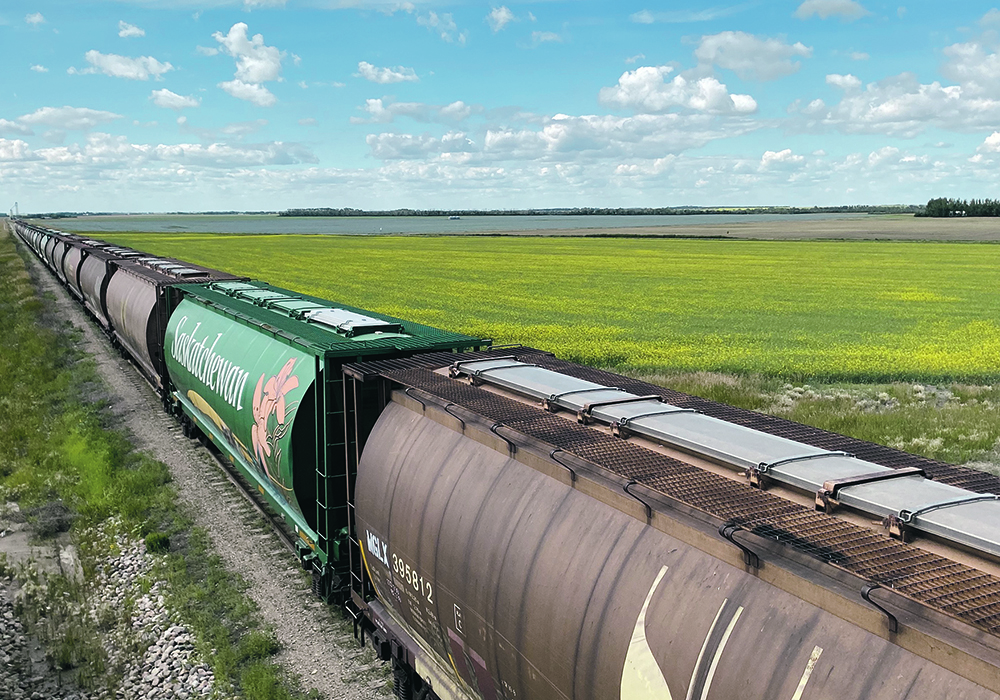Railways work to increase staffing levels as quickly as possible as grain sector prepares for much bigger crop than last year
The amount of grain in storage at prairie elevators is growing quickly, following consecutive weeks of brisk producer deliveries across the West.
According to the Grain Monitoring Program, managed by Edmonton-based Quorum Corp., producer deliveries to country elevators in Week 5 of the 2022-23 crop year exceeded 1.5 million tonnes.
The monitoring program said that pushed grain stocks in-store at country elevators up to 3.3 million tonnes or 61 percent of working capacity, compared with 2.4 million tonnes (43 percent of working capacity) a week earlier.
Quorum president Mark Hemmes said producer deliveries have been flowing into country elevators at a steady pace.
Read Also

Agri-business and farms front and centre for Alberta’s Open Farm Days
Open Farm Days continues to enjoy success in its 14th year running, as Alberta farms and agri-businesses were showcased to increase awareness on how food gets to the dinner plate.
The question that supply chain partners are asking now is: how well will the railways respond?
“Last year, even though we had a crop that was 40 percent smaller than normal, railway performance was not stellar,” Hemmes said.
“But I’m cautiously optimistic that things will get better. The issue this year is really going to be about crews…. And they (the railways) are making earnest attempts to get their staffing levels back up to where they need to be.”
According to Hemmes, grain industry sources are expecting good crop volumes across most of Western Canada this year. Overall harvest volumes should be in line with the three-year average, marking a return to more normal rail service demand from commercial grain shippers.
“Some of the grain companies are thinking the total grain supply is going to be north of 80 million tonnes,” Hemmes said.
“The bottom line is that we’re looking at a crop and a grain supply that is going to bring us back to essentially what the three-year average is.”
Although final production numbers from the 2022 harvest are not yet known, total grain supplies (carry-forward plus new production) could be in line with the third-largest supply on record.
“On (the supply) side everything is back to normal,” Hemmes said.
“I think at this point, probably what everyone is most nervous about is railway performance.”
In a recent telephone interview, Hemmes suggested that there could be a few transportation hiccups to start the 2022-23 grain marketing year.
With a prairie-wide drought taking a huge bite out of western Canadian grain volumes last year, railway companies adjusted staffing levels in 2021 to match lower anticipated demand for rail service from the grain industry.
Fast-forward to September 2022 and railway companies are ramping up human resources as quickly as possible, Hemmes added.
Training programs for new workers are at or near full capacity.
Many rail workers laid off last year have probably gone on to find new jobs, so it’s not simply a matter of calling idled crews back to work.
It could take a few months yet for railways to bring staffing numbers back to where they need them.
Nonetheless, Hemmes said he is cautiously optimistic that railway performance will improve and that major logistical problems — barring floods, fires and strikes — will be avoided.
During the past few months, the impact of last year’s prairie-wide drought on agricultural production has been coming into greater focus.
According to the GMP, grain shipments from primary elevators totalled just 34.4 million tonnes in the 2021-22 crop year, a decline of more than 36 percent from 2020-21.
Similarly, shipments of grain by rail from all primary elevators, process elevators and producer car loading sites totaled 36.4 million tonnes in 2021-22, down 41 percent from the record-setting 61.6 million tonnes recorded a year earlier.
Bulk exports from western Canadian grain terminals saw a 45.7 percent year-over-year decline. Total exports from all western Canadian ports in the 2021-22 crop year came in at 24.3 million tonnes, down from 44.7 a year earlier.
According to Statistics Canada, 2021 field crop production in Western Canada came in at 47 million tonnes, a 40 percent decline from the record 78.5 million tonnes harvest recorded in 2020.
Western Canada’s total grain supply for 2021 was estimated at slightly more than 54 million tonnes (47 million tonnes of production and 7.1 million tonnes of carry forward stocks), the GMP data suggested.
That represented the smallest annual grain supply since the drought-affected production years of 2001 to 2003.
















